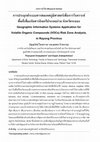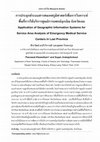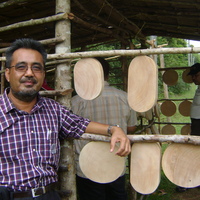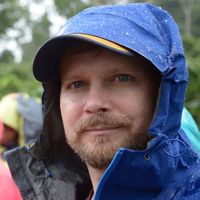Papers by Supet Jirakajohnkool
Biodiversity data jurnal, Apr 29, 2024
Tropical life sciences research, Apr 5, 2024
Atmosphere, Mar 8, 2024
This article is an open access article distributed under the terms and conditions of the Creative... more This article is an open access article distributed under the terms and conditions of the Creative Commons Attribution (CC BY
NOISE-CON ... proceedings, Nov 29, 2023
Dengue fever (DF) and dengue haemorrhagic fever (DHF) pose a constant serious risk and continue t... more Dengue fever (DF) and dengue haemorrhagic fever (DHF) pose a constant serious risk and continue to be a major public health threat in Thailand. A better understanding of the factors responsible for this affliction will enable a more precise prediction of the location and time of high-risk events. Mapping spatial distribution of disease occurrence and risk can serve as a useful tool for identifying exposures of public health concern. A Geographical Information System (GIS)-based methodology to investigate the relationship between the reported incidence of dengue fever and spatial patterns in nine districts of northern Thailand was analysed for the years 1999 to 2003. From the average prevalence of dengue cases in each district in different years, it is apparent that 2001 had the highest values, followed

Introduction Eastern Economic Corridor (EEC) has found that there is a high risk of Non-communica... more Introduction Eastern Economic Corridor (EEC) has found that there is a high risk of Non-communicable diseases (NCDs), such as cancer, blood pressure, diabetes and cerebrovascular disease, in eastern region. The rate of major NCDs increased from 4,987 per 100,000 people in 2017 to 6,121 in 2021. Methods The researchers have developed an application specifically for kidney disease patients. It serves as a resource for knowledge and facilitates greater public accessibility to healthcare, complying with SDGs in Good Health and well-being. The aims are 1) to develop the application in the EEC area with key functions of searching for nearest medical facility, booking online service, teleconferencing, and reporting in Data Visualization and 2) to evaluate the results of Mobile Health. Results We work with Geo-Informatics and Space Technology Development Agency (Public Organization) – GISTDA, secondary data from government centers are integrated with geographic information systems to displa...

Dengue fever (DF) and dengue haemorrhagic fever (DHF) pose a constant serious risk and continue t... more Dengue fever (DF) and dengue haemorrhagic fever (DHF) pose a constant serious risk and continue to be a major public health threat in Thailand. A better understanding of the factors responsible for this affliction will enable a more precise prediction of the location and time of high-risk events. Mapping spatial distribution of disease occurrence and risk can serve as a useful tool for identifying exposures of public health concern. A Geographical Information System (GIS)-based methodology to investigate the relationship between the reported incidence of dengue fever and spatial patterns in nine districts of northern Thailand was analysed for the years 1999 to 2003. From the average prevalence of dengue cases in each district in different years, it is apparent that 2001 had the highest values, followed by 2002, 1999, 2000 and 2003 in that order. With Moran’s I and Geary’s Ratio, only the year 2001 showed spatial patterns with statistical significance.

In last decade, the small industrial sector has increasingly received attention from Thai policy ... more In last decade, the small industrial sector has increasingly received attention from Thai policy makers. This study investigates the relationship between small industries and community in rural area in term of technology transfer. In the research area, knowledge and experience gathered from workplace as an employee and family businesses are the core resources to establish and run busineSses. Technically, technology transfer is divided into 2 characteristics; intra-enterprise and inter-enterprise. Intra-enterprise technology transfer comes from employers to employees, emphasizing production development. Beside, technology transfer of inter-enterprise has two directions. Firstly, direction points from the entrepreneur to material suppliers aiming to secure raw material quality. Secondly direction points from consumers to the entrepreneur aiming to put a great emphasis on product development, quality control and management.

The aims of this study were to apply the Geo-information technology for coastal vulnerability ass... more The aims of this study were to apply the Geo-information technology for coastal vulnerability assessment of Phetchaburi coast, which depended on seasonal changed (by influence of Southwest monsoon and Northeast monsoon). The assessment uses a coastal vulnerability index (CVI), consists of a physical environment vulnerability index (PVI) and the socio-economic vulnerability index (SVI) with 9 variables; coastal slope, mean tidal ranges, average wave height, rates of coastal erosion, population density, land use, built-up, transportation and coastal protection measures. The results showed, the different during monsoon had an indecisive difference effect on mean tidal ranges, average wave height, and changes in the coastline. However, the monsoon had effected to sand sediment of the beach. That increased in the Southwest monsoon and decreased in the Northeast monsoon. The level of vulnerability of the coastal area was shown by a map of CVI, with high coastal vulnerability areas having ...

Songklanakarin Journal of Science and Technology (SJST), 2012
Lepironia articulata, commonly called grey sedge or krajood, can be transformed into various prod... more Lepironia articulata, commonly called grey sedge or krajood, can be transformed into various products to generate extra income for local families in the southern part of Thailand. In recent years, the amount of Lepironia articulata used as raw material has decreased and does not currently meet the demand for the resource. Appropriate areas where natural resources and the environment can be restored and the abundance of natural produce can be increased must be sought. Therefore, this research considered the opportunity to identify appropriate areas for planting Lepironia articulata. Geographic information system (GIS) and remote sensing were integrated to map land use changes in 1990, 1998 and 2006 in the Thale Noi area. The study found that from 1990-1998, emergent aquatic areas increased by 16.18 square kilometers, the area of swamp forests increased by 15.33 square kilometers, the area of rice paddies decreased by 0.80 square kilometers, and the area of mixed orchards increased by...

Remote Sensing
Rapid population and urban growth in Bangkok increases the need for vertical city development bec... more Rapid population and urban growth in Bangkok increases the need for vertical city development because of the limited territory. This might lead to increasing land surface temperatures (LST), which makes some urban areas significantly warmer and leads to hot spots known as urban heat islands. It is known that climatic factors, such as rainfall and temperature, influence increases in dengue incidences. Thus, this research uses spatial statistical analysis to consider the association of urban LST with dengue incidences. The LST calculation methods are based on LANDSAT imageries in 2009 and 2014. Pearson correlation and Bayesian hierarchical modeling were used for predicting dengue incidences. This study found the highest correlation between the density of high-rise buildings, which had a significant influence on LST, and dengue incidences. Both the number of high-rise buildings and the surface temperature of low-rise buildings increased dengue incidence between 2009 and 2014. Overall, ...

Environment and Natural Resources Journal
Bangkok is a rapidly expanding city with existing natural areas being replaced by developed areas... more Bangkok is a rapidly expanding city with existing natural areas being replaced by developed areas creating an urban heat island (UHI) phenomenon in the city. LANDSAT imagery, near-infrared wavelength data, and time series information were used to study and to monitor the phenomenon of surface urban heat island (SUHI) in Bangkok. The variation of land surface temperature (LST) and the urban heat island intensity (UHII) phenomenon during 2008-2014 were investigated and the relationship between the UHII phenomenon and urban sprawl in Bangkok was studied. Using the UHII, we compared nine LST images of the investigated areas defined as inner, urban fringe and suburb zones. The UHI in Bangkok in the winter (dry) is higher than in the summer. Satellite imageries were used to classify the land use types as open spaces with high-rise buildings, very high density of buildings and high-rise buildings. Low vegetation index was found in urban fringe areas and inner city area with high surface temperature. The vegetation index value is high in areas of agricultural land, and low density building, it appears in suburb areas with low surface temperature. The results indicate that NDVI and High-rise building zones influence LST distribution and UHII phenomenon.

During the last 5 years, Thailand has allocated water budget to mitigate water resources problems... more During the last 5 years, Thailand has allocated water budget to mitigate water resources problems totally THB 100,460 million (US$31264 million). However, it is found no study to assess whether such allocation corresponds to the problems or to water demand. This study, therefore, assesses appropriateness of the budget allocation to 25 major basins in Thailand by applying the concept of Water Poverty Index (WPI). WPI is developed by Sullivan (2002) consisting of five main factors of Resources (R), Access (A), Capacity (C), Use (U) and Environment (E). Sub-factors of 22 variables have also been selected based on the physical and geographical characteristics of 25 major river basins. Data are scored for priority. GIS is cooperated the results of water shortage area according to priority on basin basis. It is found that WPI scores of Mae Nam Pattani, Mae Nam Kok, Peninsula - West Coast, Mae Nam Mun, Mae Nam Chi, Mae Nam Salawin and Mae Nam Khong (Northeast) were low, which reflected a higher level of water shortage than other basins. By considering water budget allocation per capita, it was found that Mae Nam Kok, Mae Nam Chi, Mae Nam Mun, were allocated less budget compared to other basins. Thus, water budget allocation is inconsistent with the water poverty index. However, the WPI scoring system is based only on water poverty. Future study should integration of disaster index into the scoring system, to improve the efficiency of budget allocation system.
This research is applied Geo-informatics to support the projects on the city's public health, Nak... more This research is applied Geo-informatics to support the projects on the city's public health, Nakhon Si Thammarat province. Geo-informatics can serve as a useful tools for the promoting the provincial public health and to monitor and plan the distribution of public health service units at Nakhon Si Thammarat province. It can be supported to extensively achieve equality in access to health care service center in this province. The level of the health care service center was divided as primary health care service (1.0), secondary level (2.1), middle-
This research had been carried out to analyze 1) the drought risk in the Chi basin area using Geo... more This research had been carried out to analyze 1) the drought risk in the Chi basin area using Geo-Informatics for Multiple Criteria Decision Analysis (MCDA), 2) any villages affected from the drought risk in Chi basin area using the index model and the procedure of MCDA, which were used for factor analysis by the Simple Additive Weighting (SAW) according to the criteria of the Office of Natural Resources and Environmental Policy and Planning. The investigated factors included rainfall, the change of rainfall, drought index, land use, irrigation zone, soil, the density of stream, the level of sub basin, and the boundary of ministry with the scale of 1:50,000.

The objective of this geographic information systems application for volatile organic compounds (... more The objective of this geographic information systems application for volatile organic compounds (VOCs) risk zone analysis in Rayong province is to study the risk areas and the impacts of the spread of volatile organic compounds in general atmosphere by using the annual average of 12-month statistics with concentration exceeding the standard values set by the Pollution Control Department. In processing with geographic information system estimating VOCs in form of a map showing the distribution by using Inverse distance weighted (IDW), it was found that, in Rayong province, there was the spread of five types of the VOCs i.e. benzene, vinyl chloride, 1,2-dichloro-ethane, chloroform and 1,3-butadiene, with 12-month moving average of concentrations exceeding the standard in general atmosphere. Monitoring was performed at the air quality monitoring points at Map Ta Phut health promoting hospital, Wat Nong Fab school, new Map Ta Phut city station, Ban Phleng community, Ban Takuan health center, Nop Ket village, Ban Nong Chok health promoting hospital and Wat Pluak Ket vicinity. According to the VOCs risk areas assessment, the risks were classified into five levels, i.e. highest, high, moderate, low, and very low. 158 villages of 406, representing 38.92 percent, were found located in the highest risk zone of 4 types of VOCs exceeding the standard. The risk was classified high and this is a major local problem that needs to be cancerned and monitoring on VOCs danger in the area of Rayong province.
การประยุกต์ระบบสารสนเทศภูมิศาสตร์เพื่อการวิเคราะห์พื้นที่เสี่ยงภัยสารอินทรีย์ระเหยง่าย จังหวัดระยอง มีวัตถุประสงค์เพื่อศึกษาพื้นที่เสี่ยงภัยและผลกระทบจากการแพร่กระจายของสารอินทรีย์ระเหยง่าย ในบรรยากาศโดยทั่วไปค่าเฉลี่ยรายปีที่มีค่าความเข้มข้นเกินค่ามาตรฐานที่กำหนดตามประกาศกรมควบคุมมลพิษ โดยใช้ระบบสารสนเทศภูมิศาสตร์ประมาณค่าเชิงพื้นที่ด้วยวิธี inverse distance weighted (IDW) พบว่าในพื้นที่จังหวัดระยองมีการแพร่กระจายของสารอินทรีย์ระเหยง่ายในบรรยากาศทั่วไปค่าเฉลี่ยรายปีที่มีค่าความเข้มข้นเกินค่ามาตรฐานค่าเฉลี่ย 12 เดือน (moving average) ในปี พ.ศ. 2556 จำนวน 5 ชนิด คือ benzene, vinyl chloride, 1,2-dichloroethane, chloroform และ 1,3-butadiene ณ บริเวณจุดตรวจวัดคุณภาพอากาศ โรงพยาบาลส่งเสริมสุขภาพตำบลมาบตาพุด โรงเรียนวัดหนองแฟบ สถานีเมืองใหม่มาบตาพุด ชุมชนบ้านพลง ศูนย์บริการสาธารณสุขบ้านตากวน หมู่บ้านนพเกตุ โรงพยาบาลส่งเสริมสุขภาพตำบลบ้านหนองจอก และบริเวณวัดปลวกเกตุ ได้มีการจัดระดับพื้นที่ที่มีความเสี่ยงภัยเป็น 5 ระดับ คือ เสี่ยงมากที่สุด เสี่ยงมาก เสี่ยงปานกลาง เสี่ยงน้อย และเสี่ยงน้อยมาก จากการศึกษาพบว่าจำนวนหมู่บ้านที่ได้รับผลกระทบจากการแพร่กระจายของสารอินทรีย์ระเหยง่ายในบรรยากาศโดยทั่วไปในเวลา 1 ปี พบหมู่บ้านอยู่ในขอบเขตพื้นที่เสี่ยงภัยระดับเสี่ยงมากที่สุดจากสารอินทรีย์ระเหยง่ายที่เกินค่ามาตรฐานจำนวน 4 ชนิด 158 หมู่บ้าน คิดเป็นร้อยละ 38.92 ซึ่งเป็นอัตราความเสี่ยงที่สูงและเป็นปัญหาที่สำคัญของหน่วยงานในท้องถิ่นที่ควรให้ความสำคัญและเฝ้าระวังภัยจากสารอินทรีย์ระเหยง่ายในเขตพื้นที่จังหวัดระยอง

Application of geographic information system (GIS) for flood hazard analysis in Chiang Mai Munici... more Application of geographic information system (GIS) for flood hazard analysis in Chiang Mai Municipality is aimed to study the flood area extent during 2005-2011 by comparing the elevation of the digital elevation model (DEM) from surveying data of terrain elevation, with different levels of 80 cm., by using light detection and ranging (LIDAR) for analysis in the plains. Flood stain data in 2011 on the flood level poles of 504 points has also been processed with GIS to estimate the flood level through interpolation technique with inverse distance weighted (IDW) equation. Such information has been worked out to determine the flood levels by means of overlay analysis in order to show the results of the areas prone to flooding and impact on the residences located in the flood risk areas. It was found that the flood peak in Chiang Mai City Municipality was at 1.73 m. and the lowest level at 0.3 m. In recurrently flooded areas, communities, particularly residential buildings with average of four people per household still living in, were found distributed in the event of early warning. Residential buildings affected by flood water level up to 1-2 meters were 177, fairly flooded between 0.5-1 meter 7,776 and below 0.5 meter 11,892. Agencies in Chiang Mai City Municipality can apply such analysis to assistance planning and management for people in the flood risk areas in appropriate way.
การประยุกต์ระบบสารสนเทศภูมิศาสตร์เพื่อวิเคราะห์พื้นที่เสี่ยงภัยน้ำท่วมในเขตเทศบาลนครเชียงใหม่มีวัตถุประสงค์เพื่อศึกษาขอบเขตพื้นที่น้ำท่วมปี พ.ศ. 2548 และ 2554 โดยเปรียบเทียบระดับความสูงจากข้อมูลแบบจำลองความสูงเชิงเลข (digital elevation model, DEM) จากข้อมูลรังวัดความสูงภูมิประเทศด้วยแสงเลเซอร์ที่ติดตั้งบนอากาศยาน (light detection and ranging, LIDAR) ที่มีความต่างระดับข้อมูล 80 เซนติเมตร สำหรับนำมาใช้วิเคราะห์ในพื้นที่ราบและข้อมูลคราบน้ำท่วมจากหลักวัดระดับน้ำท่วม ปี พ.ศ. 2554 จำนวน 504 จุด นำมาประมวลผลด้วยระบบสารสนเทศภูมิศาสตร์ในการประมาณค่าระดับของผิวน้ำท่วมด้วยเทคนิคการประมาณค่าในช่วง (interpolation) ด้วยสมการ IDW (inverse distance weighted) โดยนำข้อมูลดังกล่าวมาคำนวณหาระดับน้ำท่วมด้วยวิธีการวิเคราะห์การซ้อนทับข้อมูล (overlay analysis) เพื่อแสดงผลพื้นที่เสี่ยงภัยน้ำท่วม และวิเคราะห์ผลกระทบอาคารที่พักอาศัยที่อยู่ในบริเวณพื้นที่เสี่ยงภัยน้ำท่วม พบว่าในพื้นที่เขตเทศบาลนครเชียงใหม่มีระดับน้ำท่วมสูงสุดที่ระดับ 1.73 เมตร และต่ำสุดที่ระดับ 0.03 เมตร และบริเวณพื้นที่น้ำท่วมซ้ำซาก มีการกระจายตัวของชุมชนโดยเฉพาะอาคารที่พักอาศัยที่ยังคงมีประชาชนอาศัยอยู่ กรณีมีการแจ้งเตือนภัยล่วงหน้าเฉลี่ย 4 คนต่อหลังคาเรือน โดยมีอาคารที่พักอาศัยที่ได้รับผลกระทบจากระดับน้ำที่ท่วมสูงสุด 1-2 เมตร พบจำนวน 177 หลัง น้ำท่วมปานกลาง 0.5-1 เมตร พบ 7,776 หลัง และน้ำท่วมต่ำกว่า 0.5 เมตร พบ 11,892 หลัง ซึ่งหน่วยงานในเขตเทศบาลนครเชียงใหม่สามารถนำไปวางแผนและบริหารจัดการช่วยเหลือประชาชนในเขตพื้นที่เสี่ยงภัยน้ำท่วมได้อย่างเหมาะสม

Application of geographic information system for Service Analysis of Emergency Medical Service Ce... more Application of geographic information system for Service Analysis of Emergency Medical Service Centers in Loei province is aimed to analyze the service area extent of emergency medical centers of hospitals and Tambon Health Promoting Hospitals in the province by considering elevation from the digital elevation model (DEM) and percentage of slope. Access time to the emergency medical centers is given within 10 minutes, according to the Bureau of Public Health Emergency Response, Ministry of Public Health, and prepared into the GIS database. The results shown that the service area of the hospitals had service provided in 10 minutes, with an area of 2,795 km2, accounting for 26.62 % of the total areas. The service areas of the hospitals are fit for critical patients who must be directly taken to the hospitals, for the reason of equipment and tools to help the patients. From the analysis, there were 53,794 households, accounting for 64.88 %, living in this region. For service areas of the Tambon Health Promoting Hospitals, with service provided for a period of 10 minutes, there were areas of 5,131 square kilometers, accounting for 48.87 % of the total areas. Households in this locality, from the analysis, were 78,656, accounted for 94.87 %. The results of this study can be applied to improve the emergency medical services or to increase health care units to provide more coverage areas in Loei province for public service benefits thoroughly.
การประยุกต์ระบบสารสนเทศภูมิศาสตร์เพื่อการวิเคราะห์การให้บริการศูนย์การแพทย์ฉุกเฉิน จังหวัดเลย มีวัตถุประสงค์เพื่อวิเคราะห์ขอบเขตพื้นที่การให้บริการจากศูนย์การแพทย์ฉุกเฉินของโรงพยาบาลและโรงพยาบาลส่งเสริมสุขภาพตำบลหรือสถานีอนามัย โดยพิจารณาปัจจัยด้านความสูงของพื้นผิวจากแบบจำลองความสูงเชิงเลขและเปอร์เซ็นต์ความลาดชัน โดยกำหนดเวลาการเข้าถึงบริการศูนย์การแพทย์ฉุกเฉินภายใน 10 นาที ตามข้อกำหนดของสำนักสาธารณฉุกเฉิน กระทรวงสาธารณสุข และจัดทำเป็นฐานข้อมูลระบบสารสนเทศภูมิศาสตร์ ผลการศึกษาพบว่าพื้นที่ให้บริการจากโรงพยาบาลมีพื้นที่ให้บริการในระยะเวลา 10 นาที มีพื้นที่ 2,795 ตารางกิโลเมตร คิดเป็นร้อยละ 26.62 ของพื้นที่ทั้งหมด ซึ่งพื้นที่การให้บริการของโรงพยาบาลเหมาะสำหรับใช้กับผู้ป่วยขั้นวิกฤตที่จะต้องนำส่งโรงพยาบาลโดยตรงเนื่องจากมีอุปกรณ์และเครื่องมือที่จะช่วยเหลือชีวิตผู้ป่วย และจากการวิเคราะห์ครัวเรือนที่อยู่ในเขตนี้จำนวน 53,794 ครัวเรือน คิดเป็นร้อยละ 64.88 ส่วนพื้นที่การให้บริการจากโรงพยาบาลส่งเสริมสุขภาพตำบลมีพื้นที่ให้บริการในระยะเวลา 10 นาที เป็น 5,131 ตารางกิโลเมตร คิดเป็นร้อยละ 48.87 ของพื้นที่ทั้งหมด และจากการวิเคราะห์ครัวเรือนที่อยู่ในเขตนี้จำนวน 78,656 ครัวเรือน คิดเป็นร้อยละ 94.87 และผลจากการศึกษาครั้งนี้สามารถใช้เป็นแนวทางการพัฒนาการให้บริการการแพทย์ฉุกเฉินหรือการเพิ่มสถานพยาบาลเพื่อให้มีพื้นที่ครอบคลุมพื้นที่จังหวัดเลยมากยิ่งขึ้น เพื่อเป็นประโยชน์ในการให้บริการประชาชนอย่างทั่วถึง











Uploads
Papers by Supet Jirakajohnkool
การประยุกต์ระบบสารสนเทศภูมิศาสตร์เพื่อการวิเคราะห์พื้นที่เสี่ยงภัยสารอินทรีย์ระเหยง่าย จังหวัดระยอง มีวัตถุประสงค์เพื่อศึกษาพื้นที่เสี่ยงภัยและผลกระทบจากการแพร่กระจายของสารอินทรีย์ระเหยง่าย ในบรรยากาศโดยทั่วไปค่าเฉลี่ยรายปีที่มีค่าความเข้มข้นเกินค่ามาตรฐานที่กำหนดตามประกาศกรมควบคุมมลพิษ โดยใช้ระบบสารสนเทศภูมิศาสตร์ประมาณค่าเชิงพื้นที่ด้วยวิธี inverse distance weighted (IDW) พบว่าในพื้นที่จังหวัดระยองมีการแพร่กระจายของสารอินทรีย์ระเหยง่ายในบรรยากาศทั่วไปค่าเฉลี่ยรายปีที่มีค่าความเข้มข้นเกินค่ามาตรฐานค่าเฉลี่ย 12 เดือน (moving average) ในปี พ.ศ. 2556 จำนวน 5 ชนิด คือ benzene, vinyl chloride, 1,2-dichloroethane, chloroform และ 1,3-butadiene ณ บริเวณจุดตรวจวัดคุณภาพอากาศ โรงพยาบาลส่งเสริมสุขภาพตำบลมาบตาพุด โรงเรียนวัดหนองแฟบ สถานีเมืองใหม่มาบตาพุด ชุมชนบ้านพลง ศูนย์บริการสาธารณสุขบ้านตากวน หมู่บ้านนพเกตุ โรงพยาบาลส่งเสริมสุขภาพตำบลบ้านหนองจอก และบริเวณวัดปลวกเกตุ ได้มีการจัดระดับพื้นที่ที่มีความเสี่ยงภัยเป็น 5 ระดับ คือ เสี่ยงมากที่สุด เสี่ยงมาก เสี่ยงปานกลาง เสี่ยงน้อย และเสี่ยงน้อยมาก จากการศึกษาพบว่าจำนวนหมู่บ้านที่ได้รับผลกระทบจากการแพร่กระจายของสารอินทรีย์ระเหยง่ายในบรรยากาศโดยทั่วไปในเวลา 1 ปี พบหมู่บ้านอยู่ในขอบเขตพื้นที่เสี่ยงภัยระดับเสี่ยงมากที่สุดจากสารอินทรีย์ระเหยง่ายที่เกินค่ามาตรฐานจำนวน 4 ชนิด 158 หมู่บ้าน คิดเป็นร้อยละ 38.92 ซึ่งเป็นอัตราความเสี่ยงที่สูงและเป็นปัญหาที่สำคัญของหน่วยงานในท้องถิ่นที่ควรให้ความสำคัญและเฝ้าระวังภัยจากสารอินทรีย์ระเหยง่ายในเขตพื้นที่จังหวัดระยอง
การประยุกต์ระบบสารสนเทศภูมิศาสตร์เพื่อวิเคราะห์พื้นที่เสี่ยงภัยน้ำท่วมในเขตเทศบาลนครเชียงใหม่มีวัตถุประสงค์เพื่อศึกษาขอบเขตพื้นที่น้ำท่วมปี พ.ศ. 2548 และ 2554 โดยเปรียบเทียบระดับความสูงจากข้อมูลแบบจำลองความสูงเชิงเลข (digital elevation model, DEM) จากข้อมูลรังวัดความสูงภูมิประเทศด้วยแสงเลเซอร์ที่ติดตั้งบนอากาศยาน (light detection and ranging, LIDAR) ที่มีความต่างระดับข้อมูล 80 เซนติเมตร สำหรับนำมาใช้วิเคราะห์ในพื้นที่ราบและข้อมูลคราบน้ำท่วมจากหลักวัดระดับน้ำท่วม ปี พ.ศ. 2554 จำนวน 504 จุด นำมาประมวลผลด้วยระบบสารสนเทศภูมิศาสตร์ในการประมาณค่าระดับของผิวน้ำท่วมด้วยเทคนิคการประมาณค่าในช่วง (interpolation) ด้วยสมการ IDW (inverse distance weighted) โดยนำข้อมูลดังกล่าวมาคำนวณหาระดับน้ำท่วมด้วยวิธีการวิเคราะห์การซ้อนทับข้อมูล (overlay analysis) เพื่อแสดงผลพื้นที่เสี่ยงภัยน้ำท่วม และวิเคราะห์ผลกระทบอาคารที่พักอาศัยที่อยู่ในบริเวณพื้นที่เสี่ยงภัยน้ำท่วม พบว่าในพื้นที่เขตเทศบาลนครเชียงใหม่มีระดับน้ำท่วมสูงสุดที่ระดับ 1.73 เมตร และต่ำสุดที่ระดับ 0.03 เมตร และบริเวณพื้นที่น้ำท่วมซ้ำซาก มีการกระจายตัวของชุมชนโดยเฉพาะอาคารที่พักอาศัยที่ยังคงมีประชาชนอาศัยอยู่ กรณีมีการแจ้งเตือนภัยล่วงหน้าเฉลี่ย 4 คนต่อหลังคาเรือน โดยมีอาคารที่พักอาศัยที่ได้รับผลกระทบจากระดับน้ำที่ท่วมสูงสุด 1-2 เมตร พบจำนวน 177 หลัง น้ำท่วมปานกลาง 0.5-1 เมตร พบ 7,776 หลัง และน้ำท่วมต่ำกว่า 0.5 เมตร พบ 11,892 หลัง ซึ่งหน่วยงานในเขตเทศบาลนครเชียงใหม่สามารถนำไปวางแผนและบริหารจัดการช่วยเหลือประชาชนในเขตพื้นที่เสี่ยงภัยน้ำท่วมได้อย่างเหมาะสม
การประยุกต์ระบบสารสนเทศภูมิศาสตร์เพื่อการวิเคราะห์การให้บริการศูนย์การแพทย์ฉุกเฉิน จังหวัดเลย มีวัตถุประสงค์เพื่อวิเคราะห์ขอบเขตพื้นที่การให้บริการจากศูนย์การแพทย์ฉุกเฉินของโรงพยาบาลและโรงพยาบาลส่งเสริมสุขภาพตำบลหรือสถานีอนามัย โดยพิจารณาปัจจัยด้านความสูงของพื้นผิวจากแบบจำลองความสูงเชิงเลขและเปอร์เซ็นต์ความลาดชัน โดยกำหนดเวลาการเข้าถึงบริการศูนย์การแพทย์ฉุกเฉินภายใน 10 นาที ตามข้อกำหนดของสำนักสาธารณฉุกเฉิน กระทรวงสาธารณสุข และจัดทำเป็นฐานข้อมูลระบบสารสนเทศภูมิศาสตร์ ผลการศึกษาพบว่าพื้นที่ให้บริการจากโรงพยาบาลมีพื้นที่ให้บริการในระยะเวลา 10 นาที มีพื้นที่ 2,795 ตารางกิโลเมตร คิดเป็นร้อยละ 26.62 ของพื้นที่ทั้งหมด ซึ่งพื้นที่การให้บริการของโรงพยาบาลเหมาะสำหรับใช้กับผู้ป่วยขั้นวิกฤตที่จะต้องนำส่งโรงพยาบาลโดยตรงเนื่องจากมีอุปกรณ์และเครื่องมือที่จะช่วยเหลือชีวิตผู้ป่วย และจากการวิเคราะห์ครัวเรือนที่อยู่ในเขตนี้จำนวน 53,794 ครัวเรือน คิดเป็นร้อยละ 64.88 ส่วนพื้นที่การให้บริการจากโรงพยาบาลส่งเสริมสุขภาพตำบลมีพื้นที่ให้บริการในระยะเวลา 10 นาที เป็น 5,131 ตารางกิโลเมตร คิดเป็นร้อยละ 48.87 ของพื้นที่ทั้งหมด และจากการวิเคราะห์ครัวเรือนที่อยู่ในเขตนี้จำนวน 78,656 ครัวเรือน คิดเป็นร้อยละ 94.87 และผลจากการศึกษาครั้งนี้สามารถใช้เป็นแนวทางการพัฒนาการให้บริการการแพทย์ฉุกเฉินหรือการเพิ่มสถานพยาบาลเพื่อให้มีพื้นที่ครอบคลุมพื้นที่จังหวัดเลยมากยิ่งขึ้น เพื่อเป็นประโยชน์ในการให้บริการประชาชนอย่างทั่วถึง
การประยุกต์ระบบสารสนเทศภูมิศาสตร์เพื่อการวิเคราะห์พื้นที่เสี่ยงภัยสารอินทรีย์ระเหยง่าย จังหวัดระยอง มีวัตถุประสงค์เพื่อศึกษาพื้นที่เสี่ยงภัยและผลกระทบจากการแพร่กระจายของสารอินทรีย์ระเหยง่าย ในบรรยากาศโดยทั่วไปค่าเฉลี่ยรายปีที่มีค่าความเข้มข้นเกินค่ามาตรฐานที่กำหนดตามประกาศกรมควบคุมมลพิษ โดยใช้ระบบสารสนเทศภูมิศาสตร์ประมาณค่าเชิงพื้นที่ด้วยวิธี inverse distance weighted (IDW) พบว่าในพื้นที่จังหวัดระยองมีการแพร่กระจายของสารอินทรีย์ระเหยง่ายในบรรยากาศทั่วไปค่าเฉลี่ยรายปีที่มีค่าความเข้มข้นเกินค่ามาตรฐานค่าเฉลี่ย 12 เดือน (moving average) ในปี พ.ศ. 2556 จำนวน 5 ชนิด คือ benzene, vinyl chloride, 1,2-dichloroethane, chloroform และ 1,3-butadiene ณ บริเวณจุดตรวจวัดคุณภาพอากาศ โรงพยาบาลส่งเสริมสุขภาพตำบลมาบตาพุด โรงเรียนวัดหนองแฟบ สถานีเมืองใหม่มาบตาพุด ชุมชนบ้านพลง ศูนย์บริการสาธารณสุขบ้านตากวน หมู่บ้านนพเกตุ โรงพยาบาลส่งเสริมสุขภาพตำบลบ้านหนองจอก และบริเวณวัดปลวกเกตุ ได้มีการจัดระดับพื้นที่ที่มีความเสี่ยงภัยเป็น 5 ระดับ คือ เสี่ยงมากที่สุด เสี่ยงมาก เสี่ยงปานกลาง เสี่ยงน้อย และเสี่ยงน้อยมาก จากการศึกษาพบว่าจำนวนหมู่บ้านที่ได้รับผลกระทบจากการแพร่กระจายของสารอินทรีย์ระเหยง่ายในบรรยากาศโดยทั่วไปในเวลา 1 ปี พบหมู่บ้านอยู่ในขอบเขตพื้นที่เสี่ยงภัยระดับเสี่ยงมากที่สุดจากสารอินทรีย์ระเหยง่ายที่เกินค่ามาตรฐานจำนวน 4 ชนิด 158 หมู่บ้าน คิดเป็นร้อยละ 38.92 ซึ่งเป็นอัตราความเสี่ยงที่สูงและเป็นปัญหาที่สำคัญของหน่วยงานในท้องถิ่นที่ควรให้ความสำคัญและเฝ้าระวังภัยจากสารอินทรีย์ระเหยง่ายในเขตพื้นที่จังหวัดระยอง
การประยุกต์ระบบสารสนเทศภูมิศาสตร์เพื่อวิเคราะห์พื้นที่เสี่ยงภัยน้ำท่วมในเขตเทศบาลนครเชียงใหม่มีวัตถุประสงค์เพื่อศึกษาขอบเขตพื้นที่น้ำท่วมปี พ.ศ. 2548 และ 2554 โดยเปรียบเทียบระดับความสูงจากข้อมูลแบบจำลองความสูงเชิงเลข (digital elevation model, DEM) จากข้อมูลรังวัดความสูงภูมิประเทศด้วยแสงเลเซอร์ที่ติดตั้งบนอากาศยาน (light detection and ranging, LIDAR) ที่มีความต่างระดับข้อมูล 80 เซนติเมตร สำหรับนำมาใช้วิเคราะห์ในพื้นที่ราบและข้อมูลคราบน้ำท่วมจากหลักวัดระดับน้ำท่วม ปี พ.ศ. 2554 จำนวน 504 จุด นำมาประมวลผลด้วยระบบสารสนเทศภูมิศาสตร์ในการประมาณค่าระดับของผิวน้ำท่วมด้วยเทคนิคการประมาณค่าในช่วง (interpolation) ด้วยสมการ IDW (inverse distance weighted) โดยนำข้อมูลดังกล่าวมาคำนวณหาระดับน้ำท่วมด้วยวิธีการวิเคราะห์การซ้อนทับข้อมูล (overlay analysis) เพื่อแสดงผลพื้นที่เสี่ยงภัยน้ำท่วม และวิเคราะห์ผลกระทบอาคารที่พักอาศัยที่อยู่ในบริเวณพื้นที่เสี่ยงภัยน้ำท่วม พบว่าในพื้นที่เขตเทศบาลนครเชียงใหม่มีระดับน้ำท่วมสูงสุดที่ระดับ 1.73 เมตร และต่ำสุดที่ระดับ 0.03 เมตร และบริเวณพื้นที่น้ำท่วมซ้ำซาก มีการกระจายตัวของชุมชนโดยเฉพาะอาคารที่พักอาศัยที่ยังคงมีประชาชนอาศัยอยู่ กรณีมีการแจ้งเตือนภัยล่วงหน้าเฉลี่ย 4 คนต่อหลังคาเรือน โดยมีอาคารที่พักอาศัยที่ได้รับผลกระทบจากระดับน้ำที่ท่วมสูงสุด 1-2 เมตร พบจำนวน 177 หลัง น้ำท่วมปานกลาง 0.5-1 เมตร พบ 7,776 หลัง และน้ำท่วมต่ำกว่า 0.5 เมตร พบ 11,892 หลัง ซึ่งหน่วยงานในเขตเทศบาลนครเชียงใหม่สามารถนำไปวางแผนและบริหารจัดการช่วยเหลือประชาชนในเขตพื้นที่เสี่ยงภัยน้ำท่วมได้อย่างเหมาะสม
การประยุกต์ระบบสารสนเทศภูมิศาสตร์เพื่อการวิเคราะห์การให้บริการศูนย์การแพทย์ฉุกเฉิน จังหวัดเลย มีวัตถุประสงค์เพื่อวิเคราะห์ขอบเขตพื้นที่การให้บริการจากศูนย์การแพทย์ฉุกเฉินของโรงพยาบาลและโรงพยาบาลส่งเสริมสุขภาพตำบลหรือสถานีอนามัย โดยพิจารณาปัจจัยด้านความสูงของพื้นผิวจากแบบจำลองความสูงเชิงเลขและเปอร์เซ็นต์ความลาดชัน โดยกำหนดเวลาการเข้าถึงบริการศูนย์การแพทย์ฉุกเฉินภายใน 10 นาที ตามข้อกำหนดของสำนักสาธารณฉุกเฉิน กระทรวงสาธารณสุข และจัดทำเป็นฐานข้อมูลระบบสารสนเทศภูมิศาสตร์ ผลการศึกษาพบว่าพื้นที่ให้บริการจากโรงพยาบาลมีพื้นที่ให้บริการในระยะเวลา 10 นาที มีพื้นที่ 2,795 ตารางกิโลเมตร คิดเป็นร้อยละ 26.62 ของพื้นที่ทั้งหมด ซึ่งพื้นที่การให้บริการของโรงพยาบาลเหมาะสำหรับใช้กับผู้ป่วยขั้นวิกฤตที่จะต้องนำส่งโรงพยาบาลโดยตรงเนื่องจากมีอุปกรณ์และเครื่องมือที่จะช่วยเหลือชีวิตผู้ป่วย และจากการวิเคราะห์ครัวเรือนที่อยู่ในเขตนี้จำนวน 53,794 ครัวเรือน คิดเป็นร้อยละ 64.88 ส่วนพื้นที่การให้บริการจากโรงพยาบาลส่งเสริมสุขภาพตำบลมีพื้นที่ให้บริการในระยะเวลา 10 นาที เป็น 5,131 ตารางกิโลเมตร คิดเป็นร้อยละ 48.87 ของพื้นที่ทั้งหมด และจากการวิเคราะห์ครัวเรือนที่อยู่ในเขตนี้จำนวน 78,656 ครัวเรือน คิดเป็นร้อยละ 94.87 และผลจากการศึกษาครั้งนี้สามารถใช้เป็นแนวทางการพัฒนาการให้บริการการแพทย์ฉุกเฉินหรือการเพิ่มสถานพยาบาลเพื่อให้มีพื้นที่ครอบคลุมพื้นที่จังหวัดเลยมากยิ่งขึ้น เพื่อเป็นประโยชน์ในการให้บริการประชาชนอย่างทั่วถึง